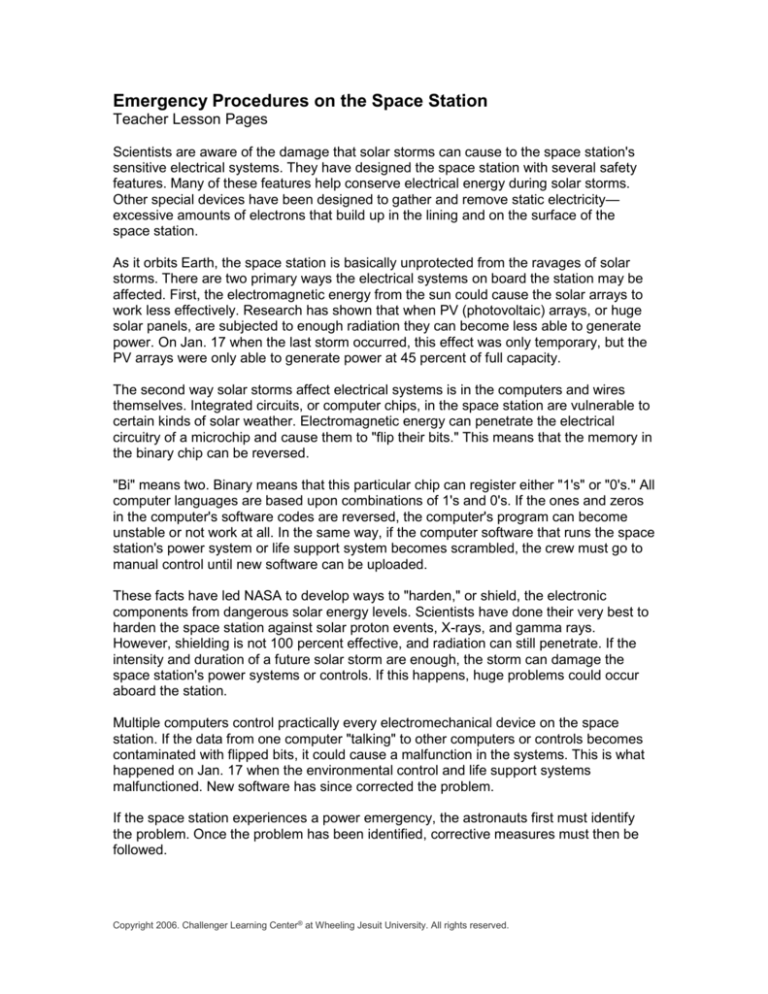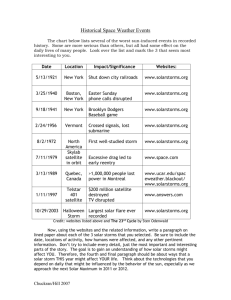
Emergency Procedures on the Space Station
Teacher Lesson Pages
Scientists are aware of the damage that solar storms can cause to the space station's
sensitive electrical systems. They have designed the space station with several safety
features. Many of these features help conserve electrical energy during solar storms.
Other special devices have been designed to gather and remove static electricity—
excessive amounts of electrons that build up in the lining and on the surface of the
space station.
As it orbits Earth, the space station is basically unprotected from the ravages of solar
storms. There are two primary ways the electrical systems on board the station may be
affected. First, the electromagnetic energy from the sun could cause the solar arrays to
work less effectively. Research has shown that when PV (photovoltaic) arrays, or huge
solar panels, are subjected to enough radiation they can become less able to generate
power. On Jan. 17 when the last storm occurred, this effect was only temporary, but the
PV arrays were only able to generate power at 45 percent of full capacity.
The second way solar storms affect electrical systems is in the computers and wires
themselves. Integrated circuits, or computer chips, in the space station are vulnerable to
certain kinds of solar weather. Electromagnetic energy can penetrate the electrical
circuitry of a microchip and cause them to "flip their bits." This means that the memory in
the binary chip can be reversed.
"Bi" means two. Binary means that this particular chip can register either "1's" or "0's." All
computer languages are based upon combinations of 1's and 0's. If the ones and zeros
in the computer's software codes are reversed, the computer's program can become
unstable or not work at all. In the same way, if the computer software that runs the space
station's power system or life support system becomes scrambled, the crew must go to
manual control until new software can be uploaded.
These facts have led NASA to develop ways to "harden," or shield, the electronic
components from dangerous solar energy levels. Scientists have done their very best to
harden the space station against solar proton events, X-rays, and gamma rays.
However, shielding is not 100 percent effective, and radiation can still penetrate. If the
intensity and duration of a future solar storm are enough, the storm can damage the
space station's power systems or controls. If this happens, huge problems could occur
aboard the station.
Multiple computers control practically every electromechanical device on the space
station. If the data from one computer "talking" to other computers or controls becomes
contaminated with flipped bits, it could cause a malfunction in the systems. This is what
happened on Jan. 17 when the environmental control and life support systems
malfunctioned. New software has since corrected the problem.
If the space station experiences a power emergency, the astronauts first must identify
the problem. Once the problem has been identified, corrective measures must then be
followed.
Copyright 2006. Challenger Learning Center® at Wheeling Jesuit University. All rights reserved.
If the output of the solar arrays is lessened and the ability to generate power is reduced,
conserving the remaining battery power is essential. The designers of the space station
have determined that a 50 percent total power reduction is a critical value not to fall
below. If the reserve power levels approach 50 percent of capacity, steps must be taken
to reduce the total power draw of the space station. That means the astronauts would
cut how much power some systems are consuming as a way to save overall battery
power. The astronauts can selectively control the amount of power that is delivered
throughout the space station, within specified limits, to weather the storm until the solar
arrays return to normal operation. For example, they can dim the lights, shut down any
device that’s not critical, and they can evacuate any module, which then eliminates the
need to generate light, heating, cooling, and breathable oxygen there
There are procedures governing the amount of reduction each system can tolerate. The
power to conduct experiments and to run anything not critical to support life and safety is
the first to be reduced or completely turned off. Each of the other support systems is to
be reduced in a sequence that will maintain safety and station control. The absolute
minimum power requirements and operating levels have been established by the design
engineers for each of the systems on board the station.
Check for understanding
Answer the following questions to see how much you know about emergency
procedures on the space station.
1. Name two ways solar storms can damage the space station.
The electromagnetic energy causes the solar arrays to produce less power. The
storm affects the way the computers and wires on board the station work. The
electromagnetic energy can penetrate the circuitry of the computer microchips and
cause them to “flip their bits.” The memory of the chip is reversed, and the computer
program will not work correctly.
2. What has been done to protect the space station from dangerous solar energy
levels?
Several types of shielding materials are used to help protect the station and the
astronauts inside. Multiple computers control nearly every device on the station in
case one fails. Engineers have calculated exactly how much power is needed to
safely run the station in emergency conditions, and astronauts reduce the power
needed or completely shut off systems that are not essential in order to maintain
power to essential systems.
Copyright 2006. Challenger Learning Center® at Wheeling Jesuit University. All rights reserved.





